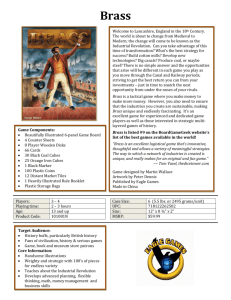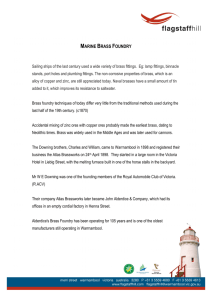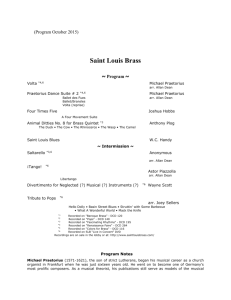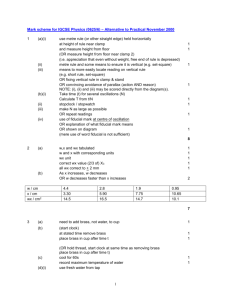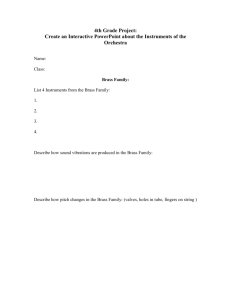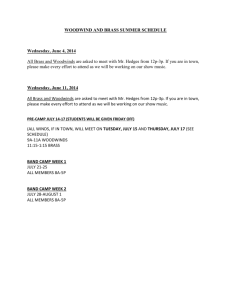Saint Louis Brass UNIVERSITY OF SOUTH ALABAMA
advertisement
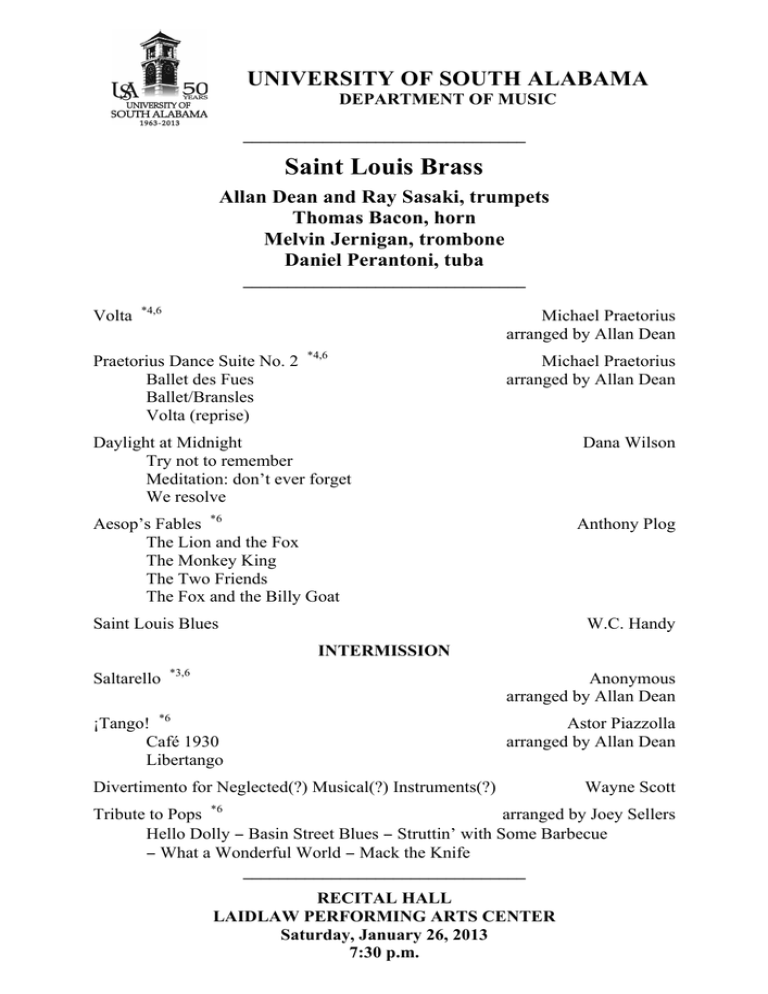
UNIVERSITY OF SOUTH ALABAMA DEPARTMENT OF MUSIC ________________________________ Saint Louis Brass Allan Dean and Ray Sasaki, trumpets Thomas Bacon, horn Melvin Jernigan, trombone Daniel Perantoni, tuba ________________________________ Volta *4,6 Michael Praetorius arranged by Allan Dean Praetorius Dance Suite No. 2 Ballet des Fues Ballet/Bransles Volta (reprise) *4,6 Michael Praetorius arranged by Allan Dean Daylight at Midnight Try not to remember Meditation: don’t ever forget We resolve Dana Wilson Aesop’s Fables *6 The Lion and the Fox The Monkey King The Two Friends The Fox and the Billy Goat Anthony Plog Saint Louis Blues W.C. Handy INTERMISSION Saltarello *3,6 Anonymous arranged by Allan Dean ¡Tango! *6 Café 1930 Libertango Astor Piazzolla arranged by Allan Dean Divertimento for Neglected(?) Musical(?) Instruments(?) Wayne Scott Tribute to Pops *6 arranged by Joey Sellers Hello Dolly − Basin Street Blues − Struttin’ with Some Barbecue − What a Wonderful World − Mack the Knife ________________________________ RECITAL HALL LAIDLAW PERFORMING ARTS CENTER Saturday, January 26, 2013 7:30 p.m. Program Notes Michael Praetorius (1571-1621), the son of strict Lutherans, began his musical career as a church organist in Frankfurt when he was just sixteen years old. He went on to become one of Germany's most prolific composers. As a musical theorist, his publications still serve as models of the musical styles and practices of the Renaissance period. Tonight's Volta and the Dance Suite #2 are taken from the composer's landmark collection of 312 instrumental French dances, Terpsichore, which was first published in 1612. Dana Wilson (b. 1946), composer, jazz pianist and teacher, currently resides in Ithaca, New York where he is Professor of Music at Ithaca College. His music has been commissioned and performed by such ensembles as the Chicago Chamber Musicians, Detroit Chamber Winds and Strings, Buffalo Philharmonic, Memphis Symphony, Washington military bands, Netherlands Wind Ensemble, Syracuse Symphony, and the Tokyo Kosei Wind Orchestra. The title Daylight at Midnight is intended to reflect elements of despair and hope captured so movingly in Arthur Koestler’s novel Darkness at Noon. Though Koestler wrote about another time and place, grave issues are still very much alive in contemporary American life. At the same time, this work’s emphasis on daylight suggests an unerring optimism, delusional though it may be. The first movement begins with quiet, night sounds but quickly evolves to the sounds of people desperately trying to party. Soloists emerge, imploring the revelers to deal with the issues at hand, but the frantic dance only intensifies. The second movement is a mournful meditation, while the third movement is resolute, garnering strength to find and nourish daylight at midnight. Aesop’s Fables − Before Aristotle and Plato, before Buddha and Confucius, in an age when the calendar had ten months, the year had 354 days, and people told time with a sun dial, Aesop told his Fables. He was born into slavery in the ancient country of Phrygia (now Turkey) and earned freedom by exposing the foibles and failings of human character through the telling of "beast tales." Then in the year 560 B.C., when Aesop was 60 years old, the telling also earned him his death while on a mission to the Oracle at Delphi. The Delphians, deeply offended by critical sarcasm directed at them in one of his fables, hurled him to his death from a cliff outside the city. American composer Anthony Plog (b. 1947) is also a trumpet player and former member of the Saint Louis Brass. He has composed several pieces for the group. This one, written in 2001 is based on the famous stories told by Aesop. We hope you will enjoy it more than the Delphians enjoyed the last story Aesop ever told! W.C. Handy (1873–1958) was a blues composer and musician, and though he was one of many musicians who played that distinctively American form of music, he is credited with giving it its contemporary form, and is widely known as the “Father of the Blues.” He took the blues from a regional music style with a limited audience to one of the dominant forces in American popular music in the first half of the twentieth century. Writing about the first time Saint Louis Blues was played in 1914, Handy said, “When Saint Louis Blues was written the tango was in vogue. I tricked the dancers by arranging a tango introduction, breaking abruptly into a low-down blues. My eyes swept the floor anxiously, then suddenly I saw lightning strike. The dancers seemed electrified. Something within them came suddenly to life. An instinct that wanted so much to live, to fling its arms to spread joy, took them by the heels.” Saltarello, by an unknown 16th Century Italian composer, was a very popular dance tune of the early Renaissance. Its monophonic style (a single melodic line without countermelodies or harmonic accompaniment) made it easily playable by all kinds of ensembles from a lone troubadour to a Renaissance dance band of recorders, viols, cornettos and sackbuts. Allan Dean's arrangement of this popular tune starts out with a lone trumpeter (Allan) wandering onto the stage, almost troubadour style, thoughtfully playing the tune all by himself. He is answered in turn by the other trumpet, the horn, and finally the trombone. A drone is then set up by the trombone and tuba, and the melody is picked up again by the other three instruments and taken to a whirling conclusion. Astor Piazzolla (1921-1992) studied conducting with Hermann Scherchen, composition with the grand Argentine maestro Alberto Ginastera, and in Paris with the renowned Nadia Boulanger, who advised him that, in spite of all his formal musical training, he must never give up the traditional folk music of his native country, the Tango: "Here is Piazzolla, don't you ever forget." His symphonic compositions received many prestigious awards, and he composed many theater and film scores, but his renown comes from the Tango. He was a master of the quintessential Tango instrument, the bandoneon, and he developed his own compositional style, which became known as nuevo tango (new Tango). He collaborated with many great performers as diverse as jazz saxophone great Gerry Mulligan, the Kronos Quartet and Mstislav Rostropovich. Divertimento for Neglected(?) Musical(?) Instruments(?) by Wayne Scott (b. 1923) is an irreverent, though (fairly) accurate tour of the history of brass instruments. It contains music from: Vesta la Giubba (Pagliacci), Leoncavallo, 1892; Happy Birthday, Mildred and Patty Hill (tune 1893, words 1935); On the Trail (Grand Canyon Suite), F. Grofé, 1931; Take Me Out to the Ball Game, A. Von Tilzer, 1908; Over the Rainbow, Harold Arlen, 1939; The Whistler and His Dog, Arthur Pryor, 1905; Musetta's Waltz, (La Bohème), Puccini, 1896; Over There, George M. Cohan, 1917; Oh! How I Hate to Get Up in the Morning, Irving Berlin, 1918; Tiger Rag, La Rocca, 1912; National Emblem March, E. Bagley, 1906 (parody title: And the Monkey Wrapped its Tail Around the Flagpole); Quartet from Rigoletto, G. Verdi, 1851; The Marine's Hymn, melody of Offenbach, 1868; For He's a Jolly Good Fellow (or The Bear Went Over the Mountain), trad. ca. 1905. The piece closes with a raucous, and gratefully short portion of The Billboard March, John Klohr, 1901. Joey Sellers' Tribute to Pops is a medley of tunes written by or made popular by the great Louis Armstong (1901-1971), a.k.a. "Satchmo" or "Pops." Armstrong's unique playing and singing style earned him great success from his first recordings in 1923. Even long after Armstrong’s death, his recordings are still popular, and he continues to be a major influence on all kinds of musical artists. As a youngster he became leader of the band at the Colored Waifs Home in New Orleans, then went on to join King Oliver's Creole Jazz Band in Chicago, and the Fletcher Henderson Orchestra in New York. By the 1930s he was on his way to great stardom making tours to Europe and throughout the United States. During his long and amazing career Louis Armstrong appeared in over 30 films, countless television and radio shows, thousands of recordings, and worked with Ed Sullivan, The Mills Brothers, Ella Fitzgerald, Bing Crosby, Danny Kaye, Johnny Carson, Barbra Streisand, Jackie Gleason and just about everybody who was anybody in the music and entertainment business in the mid 20th century. Brief history of Saint Louis Brass Saint Louis Brass (SLB) was formed in 1964 by members of the Saint Louis Symphony, originally to play school concerts around the St. Louis area. Now more than 3,000 engagements later, the SLB is entertaining audiences worldwide and only one of the members actually lives in St. Louis. The quintet's annual schedule usually includes three, ten-day tours throughout the United States, plus international touring: Norway in 1994, Bombay, India in 1995, Japan in 1997, Mexico in 1999, Germany in 2001, and Sweden in 2003. It was out of SLB that Summit Brass (“America’s premiere large brass ensemble”) got its start. In 1985, led by trumpeter David Hickman, who was at that time a member of SLB, personnel were chosen for this new group. Since its first concerts in 1986, Summit Brass has hosted an annual institute for brass players, performed dozens of concert tours in the United States and Europe, and has recorded eleven CDs. Members of Saint Louis Brass Allan Dean, trumpet − Professor of Music, Yale School of Music – Allan lived for many years in New York City, performing with the New York Brass Quintet, and the New York Cornet and Sacbut Ensemble. As a top call freelance concert and recording artist he worked with Leonard Bernstein, Igor Stravinsky and a virtual Who's Who of the greatest musicians and composers of the 20th Century. He is a founding member of Summit Brass, and is also a renowned player of the cornetto in the group "Calliope: A Renaissance Band." He has performed at the Norfolk Chamber Music Festival, Casals Festival, Spoleto Festival, U.S.A., Banff Centre for the Arts, and Prairie Home Companion. He formerly taught at the Eastman School of Music, Manhattan School of Music, and Indiana University, and he has students in key positions throughout the world. Ray Sasaki, trumpet − Professor of Music, University of Texas at Austin – Ray is a founding member of the Tone Road Ramblers, a new music ensemble started in 1979 in NYC made up of composer/performers who commission and perform only new pieces. Since 1993 they have been a resident ensemble at the Ragdale Foundation − an artist colony in Lake Forest, Illinois. Ray has also commissioned many new works for trumpet, most notably with the Cleveland Chamber Orchestra, for the International Trumpet Guild, and the Jazz Members Orchestra of Chicago. His recorded work can be heard on the Arabesque, CRI, Deutsche Grammophon, Ubres, Crystal, Summit, Einstein and TR2001 labels. He previously was on the faculty of the University of Illinois, and has also served two terms on the Board of Directors of the International Trumpet Guild. Thomas Bacon, horn − Soloist, International Recording Artist – Tom has been principal horn with the Symphony Orchestras of Syracuse, Detroit, Houston, and the Berlin Radio, and has performed in "guest" principal positions with the Berlin Philharmonic, Pittsburgh Symphony, Milwaukee Symphony, Chicago Symphony, and many other orchestras. He has performed in Europe, Africa, Asia, North and South America, and has been featured soloist on international tours with the Amati Ensemble, the Berlin Radio Orchestra, and Mikhail Baryshnikov's White Oak Dance Project. He has played with over a hundred orchestras across the United States, at major music festivals throughout the world, and has made ten solo recordings. He is editor of The Complete Hornist series for Southern Music Company, and has given master classes and clinics at hundreds of universities and colleges around the world. Visit his web site at www.hornplanet.com Melvyn Jernigan, trombone − Executive Director, Primo Concerts – For many years Mel was Bass Trombonist with the Saint Louis Symphony Orchestra, having joined the orchestra right after graduating from the Curtis Institute of Music. He is the founding member of the Saint Louis Brass and is also a founding member of Summit Brass. In addition to his performing duties, Mel manages Primo Concerts, which handles bookings for the Saint Louis Brass, Summit Brass and The RiverCity Ramblers, a Dixieland jazz group. He is a recording and television producer as well as an arts manager, and has served on various committees and/or boards of the Missouri Arts Council, the Mid-America Arts Alliance, ACUCAA, Young Audiences St. Louis, Summit Brass and Summit Records. Daniel Perantoni, tuba − Professor of Music, Indiana University – Dan, or "Mr. P," as his students call him, is a renowned tuba soloist, clinician, chamber musician, instrument designer and master teacher. He has been a featured artist at Carnegie Hall, the Monterey Jazz Festival, the Spoleto Festival U.S.A., the Adelaide Festival in Australia, the Banff Centre for the Arts in Canada, the Montreux Brass Congress in Switzerland, and as soloist throughout Japan. He is a founding member of Summit Brass, a member of Symphonia, the Matteson - Phillips Tubajazz Consort, and has released numerous solo and chamber music CDs. Along with Robert Tucci, he designed the "Perantucci" line of low brass instruments and mouthpieces that has become the equipment choice for thousands of low brass players worldwide. He also serves as the vice-president of educational matters and consultant/clinician for Custom Music Company. Recordings are on sale in the lobby or at www.saintlouisbrass.com *1 *2 *3 *4 *5 *6 Recorded on "Baroque Brass" - DCD 120 Recorded on "Pops" - DCD 140 Recorded on "Fascinating Rhythms" - DCD 195 Recorded on "Renaissance Faire" - DCD 284 Recorded on "Colors for Brass" - DCD 116 Recorded on SLB “Live in Concert” DVD Saint Louis Brass touring is managed by: Primo Concerts 202 Central Avenue St. Louis, MO 63119 314-968-9027 800-689-9027 www.saintlouisbrass.com
